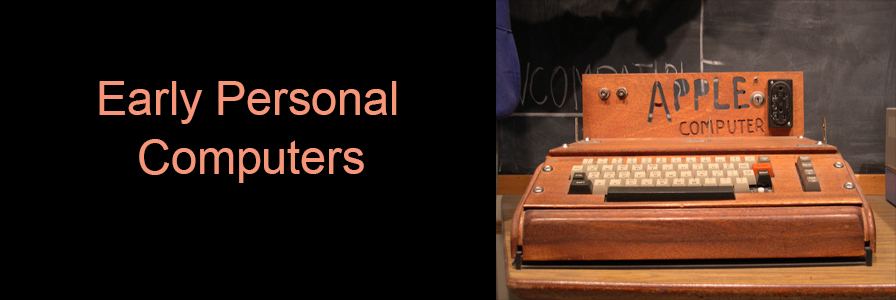The Altair 8800
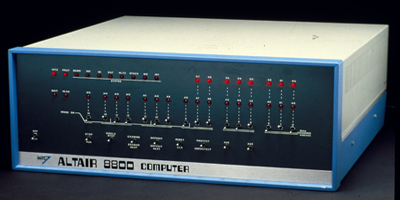
In 1974, a small firm in Albuquerque, New Mexico, named Micro Instrumentation and Telemetry Systems (MITS) announced a computer kit called the Altair, which met the requirements for a small personal computer. See the 8800 photo to the left. MITS succeeded with the product and it was their machine that inaugurated the personal computer age.
H. Edward Roberts, who headed MITS, decided to design a small, affordable computer around the Intel 8080. His daughter named the new machine after the star Altair. It was the first microcomputer to sell in relatively large numbers. In January 1975, a photograph of the Altair appeared on the cover of the magazine Popular Electronics. The caption read "World's First Minicomputer Kit to Rival Commercial Models."
The Altair was sold in kit form, although a relatively complex one, consisting of four circuit boards and many parts. Priced at $400, Roberts had hoped to break even by selling 200 Altairs. The Altair tapped into pent-up demand for a small home computer and surprised its creators when it generated thousands of orders in the first month. Unable to keep up with demand, MITS sold the design after about 10,000 kits had shipped.
The kit offered by MITS represented the minimum configuration of circuits that one could legitimately call a computer. It had a small memory, no printer, no keyboard or any other input device. Most purchasers found the kit was difficult to assemble, unless they had some prior experience with digital electronics.
The Altair, and other early clones, were pretty difficult to use. The machines contained no operating system in Read Only Memory, so starting it up required a machine language program to be entered by hand via the front-panel switches, one location at a time. The program was typically a small driver for an attached cassette tape reader, which would then be used to read in another "real" program. Later systems added bootstrapping code to improve the process, and the machines became almost universally associated with the Control Program/Monitor (CP/M) operating system, loaded from floppy disk. The Altair created a new industry of microcomputers and computer kits resulting in a wave of small business computers in the late 1970s based on the Intel 8080. Top
The Sol-20 Computer
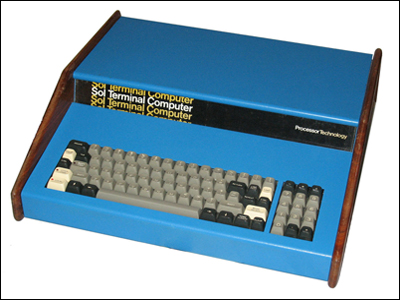
The Sol-20 was the first fully assembled microcomputer with a built-in keyboard and video display. (That combination would later become known as a personal computer.) It was built by the Processor Technology Corporation in Berkeley, California. The design was originally suggested by Les Solomon, the editor of Popular Electronics. He asked Bob Marsh of Processor Technology if he could design a smart terminal for use with the Altair 8800.
Marsh contracted Lee Felsenstein, designer of the VDM-1 graphics card, to create it. They agreed the best solution was to build a complete computer with a usable program in read-only-memory. Felsenstein suggested the computer be named "Sol" in honor of Les Soloman.
The design was a combination of an Intel 8080-based backplane, a VDM-1 graphics card, a card to drive the keyboard, and circuitry to connect to a cassette deck for program storage. Additional add-on peripheral products could be added via five S-100 bus slots at the back of the machine. The SOL-20 also included a swappable read-only-memory that contained some boot code that allowed it to start up running pre-selected programs.
The Sol appeared on the cover of the July 1976 issue of Popular Electronics as a "high-quality intelligent terminal". A Sol-20 was taken to the Personal Computing Show in Atlantic City in August 1976 where it was a huge hit. Systems began shipping late that year. They had an order backlog that took a year to fill. The Sol-20 remained in production until early 1979 with about 12,000 machines being sold. The Sol-20 was a very successful computer, but the company failed to develop a next generation product. Processor Technology ceased operations in May 1979. Top
The Beginnings Of Apple
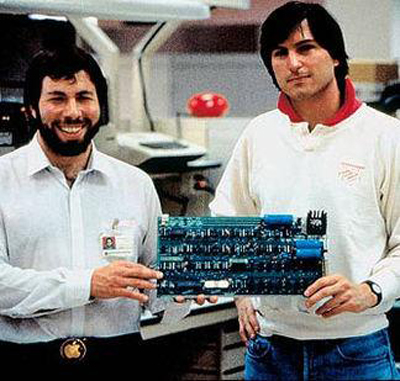
The Homebrew Computer Club was an informal group of electronic enthusiasts in Menlo Park, California who gathered to trade parts, circuits, and information pertaining to "do it yourself" construction of computing devices. It was started by Gordon French and Fred Moore. The first meeting was held on March 5, 1975 in French's garage in Menlo Park on the occasion of the arrival in the area of the first Altair 8800 microcomputer. Steve Wozniak credits that first meeting with inspiring him to design the Apple-1.
Steve Wozniak at the time was a 26 year old employee of Hewlett-Packard and a digital electronics hacker. He had been wanting to build a computer of his own for a long time. For years he had designed many on paper, and had even developed a FORTRAN compiler and a BASIC interpreter (BASIC - Beginner's All-purpose Symbolic Instruction Code - a very early high-level programming language) for his theoretical machines.
However, a lack of money kept him from carrying out his desire. In the summer of 1975, he looked at the Intel 8080 chip (the heart of the Altair), but at $179 decided he couldn’t afford it. Another chip, the Motorola 6800, interested Wozniak because it resembled his favorite minicomputer (the Data General Nova) more than the 8080.
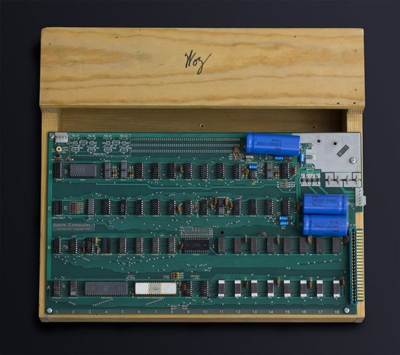
However, cost was a problem for him until he discovered a chip that was almost identical to the 6800, but considerably cheaper. MOS Technology sold their 6502 chip for $25, as opposed to the $175 Motorola 6800. Wozniak decided to go with the 6502.
Woz began writing a version of BASIC that would run on 6502. When his BASIC interpreter was finished, he turned his attention to designing the computer he could run it on. Except for some small timing differences, he was able to use the hardware design he had earlier done on paper for the 6800.
To make the computer easier to use, Wozniak favored a keyboard over the front panel switches that came on the Altair. He also made it simple to use a small television set for a video terminal. Wozniak used two 256 x 4 programmable read-only memory chips to create a 256 byte program (called a “monitor”) that looked at the keyboard when the computer was turned on. This monitor program could not do much more than allow the entry of hex (6) bytes, examine a range of memory, and run a program at a specific address.
By early 1976, Steve Wozniak had completed his 6502-based computer and would display enhancements and/or modifications at the bi-weekly Homebrew Computer Club meetings. The picture to the left above is Wozniak's working prototype that he demonstrated to the Computer Club.
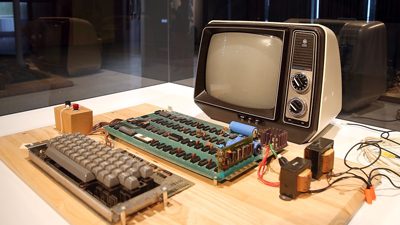
Steve Jobs (both individuals were named Steve) was a 21 year old friend of Wozniak’s and also a visitor at the Homebrew Club. He had worked with Wozniak in the past (together they designed the arcade game “Breakout” for Atari). Jobs was very interested in Wozniak’computer. During the design process Jobs made suggestions that helped shape the final product, such as the use of the newer dynamic random-access memory (RAM) instead of older, more expensive static RAM. He suggested to Wozniak that they get some printed circuit boards made for the computer and sell it at the club for people to assemble themselves.
They pooled their financial resources together to have PC boards made. The picture to the left is the original product that Woz and Jobs intended to sell. On April 1st, 1976 they officially formed the Apple Computer Company. (Jobs had recently worked at an apple orchard, and liked the name because he thought of the apple as a perfect fruit.)
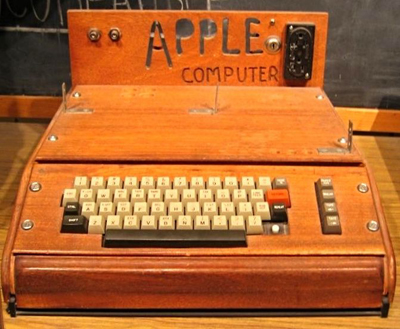
Jobs approached the owner of a new computer store in the bay area called “The Byte Shop.” The businessman, Paul Terrell, expressed an interest in the Apple Computer but wanted only fully assembled computers to sell. If they could provide this, Terrell told them he would order fifty Apples, and pay cash on delivery. Suddenly, the cost of making (and selling) this computer was considerably more than they expected. Jobs and Wozniak managed to get the parts on “net 30 days” (30 days credit without interest), and set themselves up in Job’s garage for the assembly and testing of the Apple-1.
After marathon sessions of stuffing and soldering PC boards, Jobs delivered the computers to the Byte Shop. Although these “fully assembled” computers lacked a power supply, keyboard, or monitor, Terrell bought them as promised. In July of 1976 the Apple-1 was released and sold for $666.66, which was about twice the cost of the parts plus a 33% dealer markup. To further try to enhance sales, Paul Terrell found a local cabinetmaker that made some wood cases for the Apple computer so it would no longer be just a “naked” circuit board. The final product that the Byte Shop sold is pictured to the left.
Two hundred Apple-1 computers were manufactured and sold. At last count there have been 63 identified as still in existence. Of the 63, only 6 remain in working condition. Top
The Apple II
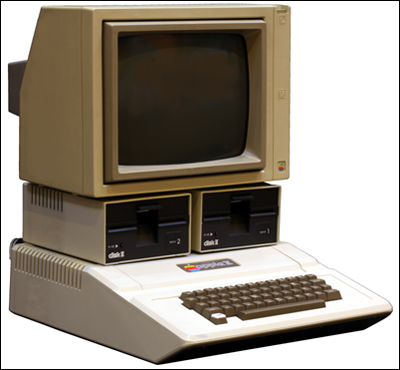
The Apple II was a big leap forward from the crude design of the Apple-1. Introduced in June, 1977, the Apple II had the beginnings of a modern personal work station. See the picture to the left of the first version of the Apple II. The computer on the bottom was self contained in an overall plastic cover. On top of the computer were two floppy disk units and on top of them was a typical independent computer screen of the day.
When Wozniak had completed the design of the Apple-1, he already had in mind a number of enhancements that would make the computer faster and more functional. He also wanted color in the display. He enhanced the Apple II by moving the display function into main memory allowing instant screen changes.
"It also needed sound", said Wozniak. "So I had to add a speaker to the Apple II. It wasn’t planned, it was just accidental". A lot of the features that really made the Apple II stand out in its day came from a game. "The fun features that were built in were only to do one pet project, which was to program a BASIC version of Breakout and show it off at the club" said Woz.
Since the 6502 processor could address a total of 64,000 bytes of memory, he designed the Apple II memory with the ability to use either 4,000 byte chips, or the newer (and more expensive) 16,000 byte chips. The first available Apple II computers came standard with 4,000 bytes of memory, and more could be added, to a maximum of 12,000 bytes (if using the 4,000 byte memory chips) or 48,000 bytes (if using the 16,000 byte chips). The Commodore PET and the Radio Shack TRS-80 competitive products could not easily be expanded beyond the 4,000 bytes they came with. The Apple II from the beginning was designed with expansion in mind.
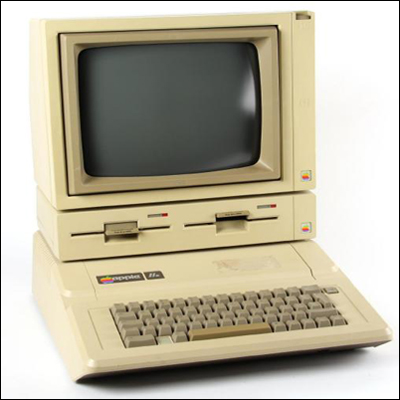
On the Apple-1, it was necessary for the owner to supply a keyboard. A specific keyboard that Apple recommended to its customers was one made by Datanetics , a company based in Fountain Valley, California. Datanetics had been in business since 1964, making keyboards for cash registers and adding machines. Steve Jobs asked Datanetics to make keyboards for the Apple II, and the company worked during the spring of 1977 to have enough keyboards available for the release of the new computer that summer. The shape and printing on the key caps was almost identical to the earlier Datanetics keyboard used on the Apple-1.
In April 1977 Byte Magazine predicted that the Apple II "may be the first product to fully qualify as an 'appliance computer' ... a completed system which is purchased off the retail shelf, taken home, plugged in and used". The computer's color graphics capability especially impressed the magazine. Although it sold well after the launch, the initial market was to hobbyists and computer enthusiasts. Sales expanded exponentially into the business and professional market when the spreadsheet program VisiCalc was launched in mid-1979. VisiCalc is credited as being the defining killer app for the microcomputer industry. Pictured to the left is the Apple IIe released in January, 1983.
During the first five years of Apple operations, revenues doubled about every four months. Between September 1977 and September 1980, annual sales grew from $775,000 to $118 million. Almost unbelievable - during this period the sole products of the company were only the Apple II computers and their peripherals, accessories, and software. Top
The IBM Personal Computer (IBM PC)
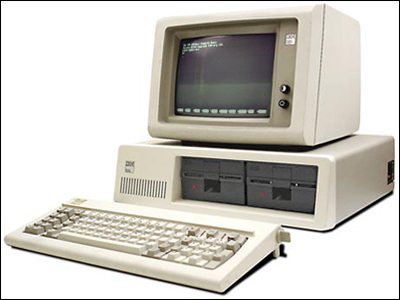
IBM's brand recognition, along with a massive marketing campaign, ignited the fast growth of the personal computer market with the announcement of its own personal computer (PC). The IBM PC revolutionized business computing by becoming the first PC to gain widespread adoption by industry. The IBM PC was widely copied and led to the creation of a vast “ecosystem” of software, peripherals, and other commodities for use with the platform.
The IBM PC was not as powerful as many of the other personal computers it was competing against at the time of its release in August of 1981. The IBM PC, formally known as the IBM Model 5150, was based on a 4.8 megahertz Intel 8088 microprocessor and used Microsoft´s MS-DOS operating system. The simplest configuration had only 16,000 bytes of on-board memory and used an audio cassette to load and save data. A floppy drive was optional, and a hard drive was not supported.
The basic PC system for home use attached to an audio tape cassette player and a television set (no floppy drives or video monitor). PC-DOS, the operating system, was not available on cassette, so the basic system was only capable of running the Microsoft BASIC programming language, which was built-in and included with every PC. The basic system sold for $1,565. A more typical system for home or school with a memory of 64K bytes, a single diskette drive and a display, was priced about $3,000. An expanded system for business with color graphics, two diskette drives, and a printer cost about $4,500. Five internal expansion slots on the motherboard provided the ability to add additional memory and other capabilities. One slot was usually occupied by a video car, and another by an optional floppy drive controller.
In order to save time and money developing their own hardware and software, IBM used available off-the-shelf components. The CPU was from Intel, and the operating system (OS) was from Microsoft, who licensed it to IBM as PC-DOS. Other companies could in theory obtain these same components and create their own version of the PC. But there was one aspect of the PC which could not be legally copied - the BIOS (Basic Input/Output System start up software) as it was copyrighted. However, it was soon reverse engineered by competitors looking to create exact compatible systems.
Although not necessarily the best machine by technological standards, IBM's expertise and the fact that the IBM PC actually looked and felt like a professional computer system made the IBM PC and subsequent PC clones extremely popular. Top
The Apple Macintosh

Apple launched the Macintosh in 1984 with an advertisement during the Super Bowl that got a lot of attention. The Macintosh was the first successful mass market mouse-driven computer with a graphical user interface. Based on the Motorola 68000 microprocessor, the Macintosh was introduced with 128 kilobytes of memory and later that year a 512 kilobyte memory model became available.
To keep costs in line, the Macintosh had a simplified motherboard design, no internal hard drive, and a single 3.5" floppy drive. The base Macintosh sold for a price of $2,495.
Applications that came with the Macintosh included MacPaint, a bit-mapped graphics program, and MacWrite, that introduced WYSIWYG (what you see is what you get) word processing.
The Macintosh became a successful personal computer for years to come. This was due to the introduction of creative software through Apple's partnership with Adobe Inc. The partnership introduced the LaserWriter printer and the PageMaker desktop publishing program to users of the personal computer.
During Steve Jobs' absence from Apple (1985 to 1997), a number of different models of Macintosh (including the Macintosh Plus and Macintosh II) were released with much success. The entire Macintosh line of personal computers was IBM's major competition up until the early 1990s. However, by the mid 1990s Apple was struggling. Steve Jobs came back in February, 1997. Steve had incredible tenacity. He led Apple back to prominence with triumph after triumph driving the company to its greatest successes - the iPod, then the iPhone, and then the iPad. He ended up creating a giant Apple corporation - one of the greatest companies of all time. Top
THIS PAGE IS STILL UNDER CONSTRUCTION
